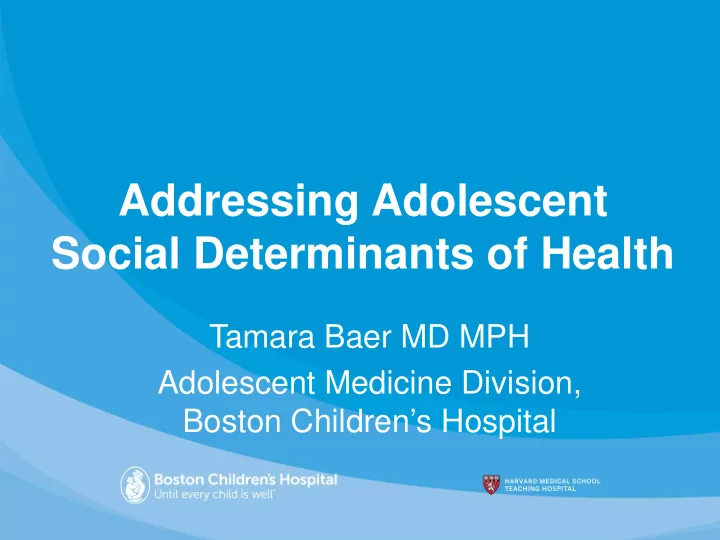

Addressing Adolescent Social Determinants of Health Tamara Baer MD MPH Adolescent Medicine Division, Boston Children’s Hospital
Objectives of this talk • Understand how social and environmental factors shape adolescent health behaviors and health outcomes • Learn about screening tools to detect social needs • Think about a framework to screen for and refer social needs in a school-based health center 2
Let’s start with a quick case 3
What are social determinants of health (SDH)? Utility Shutoffs Inadequate Violence Nutrition • Social, In the Home economic, Poor environmental Housing Bullying Conditions conditions that Adolescent Health affect individual Insufficient Lack of Special Transportation and population Education health Insufficient Illegal Household Immigration Income Status Limited Access to Health Care
Increasing recognition that SDH are a critical component of healthcare • Healthy People 2020 goal “to create social and physical environments that promote good health for all” • American Academy of Pediatrics (AAP) recommendations for pediatricians: – Increase understanding of health and social risks on child outcomes (2010) – Routinely screen for food insecurity (2015) • CMS dedicated $157m funding towards SDH models (2016)
Adolescence is a critical developmental stage Social context Genetic Physical, sexual, predisposition psychosocial, Future cognitive changes patterns of adult health Early childhood Community experiences context Risk behaviors
Adolescents experience significant health disparities • In 2011, 20% of adolescents lived below 100% of the federal poverty level • Adolescents / young adults less likely to have health insurance than any other age group • Poor and underinsured adolescents utilize fewer preventive health and reproductive health services
Health-related social problems are common • Among 401 patients at Boston Children’s Hospital Adolescent Clinic – Health-related social problems: 76% with 1; 47% with 2; 27% with ≥ 3 • Main health-related social problems – Healthcare Access (37%) – Housing (34%) – Food insecurity (29%) Hassan et al, 2013
Few healthcare providers address SDH • Despite the number of health-related social problems among children / adolescents, limited screening or referrals for resources (Fleegler et al., 2007; Garg et al., 2009)
Challenges to address SDH in Medical Home 1. Limitations to provider availability to triage SDH needs – Providers not trained to screen for health related social problems – Time constraints 2. Availability of information on useful resources – Providers have limited knowledge about resources, may think SDH not remediable 3. Availability of clinical staff to link patients with resources
Solutions to address SDH 1. Improve 2. Provide triage information on resources 3. Expand clinical staff to connect patients with resources 11
1. Triage: Screening Tools • Provider screening – HEADSS Assessment: psychosocial review • H ome, E ducation, A ctivities, D rugs, S exuality, S uicide/depression – I-HELLP Screen: basic needs screen – RAPPS-PH: social determinants screen (raaps.org) • Examples of patient self-screening – Help Steps (helpsteps.com)
I-HELLP Screen Domain/Area Examples of Questions INCOME General Does your family ever have trouble making ends meet? Food Within past 12 months have you worried food would run out? Benefits Are you / your family having problems receiving or applying for WIC, food stamps, SSI? HOUSING Costs Have you lived in more than 2 addresses in past year? Do you think you are at risk for becoming homeless? Conditions Is your housing causing health problems? Utilities In the past year, has your electricity or gas been shut off / threatened to be shut off? Do you get special services in school? EDUCATION Do you have questions about your immigration status? LEGAL STATUS How well do you speak English? How well do you read English? LITERACY PERSONAL SAFETY Domestic violence Have you ever been hurt of threatened by a relationship partner? General safety Do you feel afraid to play outside?
Food Insecurity screening and ‘Pandora's box’ • 2 item validated screen (Hager, 2010): “Within the past 12 months…” – We worried whether our food would run out before we got money to buy more – The food we bought just didn’t last and we didn’t have money to get more • Food insecurity significantly associated with increased odds of other health related social problems among teens (Baer, 2015) 14
Food security level correlated with other SDH Baer, 2015 15
2. Provide information on available resources • One reason that providers do not screen is that they have limited knowledge about resources • Resource information delivery – Website tool with collection of parent handouts: The Children’s Advocacy Project of America, CAP4KIDS (CAP4KIDS.org)
3. Expand Clinical Staff Volunteers Professionals Student volunteers Para-professionals ▪ Resource specialists ▪ Outreach workers Youth / parent advocates ▪ Utilize parents who Professionals ▪ Social Workers have had experience ▪ Case Managers accessing resources ▪ Lawyers for their own families 17
Health Leads • Health Leads (healthleadsusa.org) • Started at BMC in 1996, now > 21 Help Desks nationally, using over 800 college volunteers from 12 universities • College student volunteers trained to assist patients with meeting basic needs sit at Help Desks in urban clinics
Medical Legal Partnership (MLP) • Organization that places lawyers into the healthcare setting to benefit low-income and at- risk patients • Started in 1993 at Boston Medical Center • Now 95 MLP sites serving 54,000 patients per year at over 250 healthcare institutions • medical-legalpartnership.org
What does this mean for school- based health centers? • SBHC ideal for addressing SDH – Intersection of adolescent’s education and health – Schools are where adolescents spend majority of their time • SBHC providers, teachers and guidance counselors could be trained to screen • Schools can develop resource / referral guides or provide “on-site” resources 20
What would SDH screening potentially mean for our patient? 21
Thank You 22
Recommend
More recommend